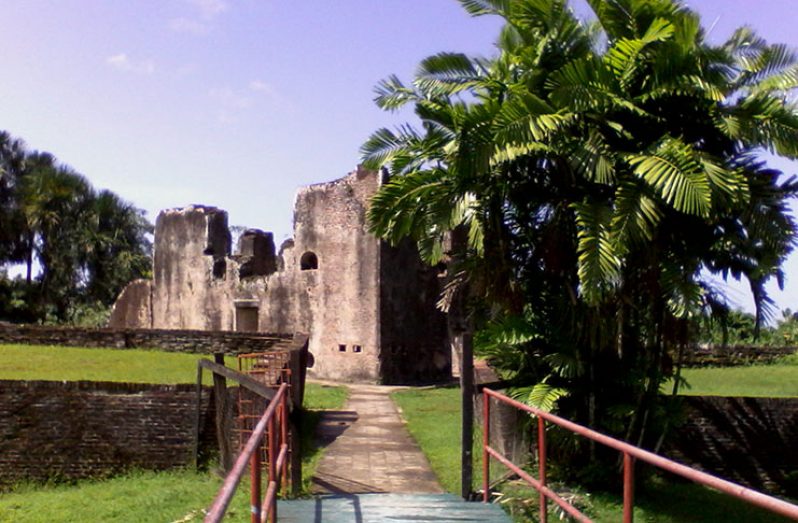FORT Island, formerly known as Flag Island, located some 16 kilometres from the mouth of the Essequibo River, was once the capital of the colonies of Essequibo and Demerara during the 16th and 17th centuries.

During its early occupation by the Dutch, the island was known as Flag Island because of a large flag that was flown there as a guide for ships.
The mighty flag is no longer in existence today. According to the Guyana National Trust, during the 17th century Essequibo blossomed from a trading post to a colony and planters began to migrate to the mouth of the Essequibo River.
As such, a centre of government and defence was built to oversee effective governance and to protect the Dutch interest in the Essequibo.
Fort Zeelandia, built in 1744 and the Court of Policy built eight years after, now a Dutch Heritage Museum and the only of its kind in Guyana, still stand today.
And today, the sparsely populated island about three square miles in length and a mile in width, is far from the busy trading post it was in its early colonial days.
The island is better remembered for these two important historical sites. In the early days, the Court of Policy building served as a church, Court House and venture office.
The brick building is in good shape, due to extensive renovations 17 years ago, and is reputedly the oldest non-military structure in Guyana.
At its peak, the island was the seat of government for the colonies of Essequibo and Demerara, but as time went by, it was overgrown and a new capital was desired.
No longer the centre of government, the Court of Policy fell into disrepair and after years of neglect, the building in 2000 was restored by the Guyana National Trust.
Extensive works were done to the roof, windows, doors and other infrastructural works to enhance visitors’ experience.
The museum is frequented by locals on weekends and foreigners mostly during the August vacation period.
BOTTLES
Inside the museum, old Dutch and English bottles and jars of varying sizes and shapes can be found, as well as early maps of Guyana.
Bottles were reportedly a part of everyday life in the colony of Essequibo. In 1782, Dutch ship, ‘Pieter Elias,’ on its way to the shores of Berbice was seized by British soldiers.
Records indicate that among the loot plundered included 8,141 bottles of red and white wines; 773 bottles of gin and brandy; 76 caskets of beer; 432 jugs of oil and vinegar; 21 jugs of fruits; and 21 chests of prepared medicines.

When the bottles were discarded, they became oddments of the early Dutch and British era in Guyana, and according to one pamphlet, the old bottles in Guyana are mainly from Britain, Belgium, France, Germany and the Netherlands.
Also in the museum is a broken African jar believed to be over 300 years old and the tomes of Commander and Court member Johames Backer; Laurens Backer, merely a year old; and Michael Roth, a doctor for the British West India Company, who died in the Essequibo River.
They were all members of the early Dutch colony.
At the gate of Fort Island, a glance north and Fort Zeelandia appears.
According to a document at the Court of Policy, the existence of the fort can be traced as early as 1679, when Dutch commander Albert Beekman articulated the need for one on the island.
Construction work started on a timber fort and was slated to be completed in September 1681, but it was never finished to serve its purpose.
In 1710, Commander Peter Van der Heyden Rusen started a petition for a brick fort to replace the unfinished one made of timber, but the petition caused some amount of conflict between the commander and the planters on the island.
As a result, the plan for the new fort was stalled. However, in August 1738, Laurens Storms van Gravesande, the Secretary to Commander Hermanus Gleskerk, inspected the wooden fort and reported that the timber structure was falling to pieces.
DUTCH INTEREST
He recommended to the Directors of the Netherlands that a new fort of brick be built to defend the interest of the Dutch West India Company against European rivals, who prowl the eastern coast of South America.

The fort was also intended to serve as a stronghold against internal forces such as rebellious slaves.
Gravesande’s recommendation was accepted and he later went on to enjoy a distinguished life in public service.
Born in the City of Hertogenbosch, Netherlands, and becoming a trained military officer at 17, Gravesande was appointed commander of Essequibo in 1742, serving longer than any other who held that post in the colonies.
After serving for more than 30 years as director-general for the counties of Essequibo and Demerara, he retired. In preserved writings, he is described as a “born leader.”
The construction of Fort Zeelandia, named after the County of Zeelandia in the Netherlands from which many of the inhabitants of the island originate, can be considered one of his first achievements as commander.
The fort similar to those built in West Africa, consisted of a redoubt of 50 square feet, with walls thick enough to endure the heaviest ordnance.

It was a two-storey building. The lower flat served as a warehouse for provisions and a safe powder house, while the upper floor housed the soldiers with a room for the non-commissioned officers.
Twenty gun ports, each holding a two or three-pounder gun were on each storey.
In 1775, Flag Island (Vlaggen Eyland in Dutch) was renamed Fort Island and on March 6, 1781, the island was captured by Capitan Day of Admiral Rodney’s British Navy Force.
But the British takeover was short-lived, as the French captured the island the following year. The Dutch regained control of the fort two years after and by 1796, the fort went into a long period of decline, as attention shifted to the colony of Demerara.



.jpg)











